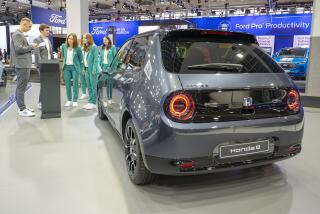Hot Ford Hybrid Is in Short Supply
- Share via
DETROIT — Get this: one of the hottest new Fords this spring is built by the Japanese--in Detroit. It is so hot that it is about to be exported to Japan.
Confused? Welcome to the future of the international auto industry.
The car is the Ford Probe, being built by Mazda in its new suburban Detroit plant. And if torrid sales are any indication, a lot of buyers either don’t know or don’t care about the Probe’s mixed heritage.
“We can’t keep them on the floor,” says Arne O’Brien, a salesman for Stark Hickey West Ford in Detroit. “We have no brochures, we have no Probes left . . . We have back orders going for at least a couple of months. People are ordering them sight unseen.”
Indeed, the hybrid Probe seems to be winning over customers because it doesn’t look much like a domestic car; it has the sleek styling that Americans once thought of as European and now expect from Japan.
There’s a good reason for that. Ford officials, knowing that they lacked a specialty product targeted at young, import buyers attracted to cars like the Honda Prelude and Toyota Celica, decided to fill the void with a front-wheel-drive performance car from its Japanese partner, Mazda.
The idea was to design a product to complement the Mustang in the sports segment of the car market. While the new Japanese car would attract upscale import buyers, the lower-priced Mustang would continue to lure traditional blue-collar muscle car enthusiasts.
Now, although the $10,500-plus Probe is built in America and carries a Ford nameplate, its Japanese roots are undeniable.
Ford’s small design studio in Hiroshima handled the exterior styling, while the basic engineering was done at Mazda’s nearby headquarters. The Probe is, after all, really just a two-door derivative of Mazda’s new 626 model. The Probe is produced on the same assembly line at Mazda’s Flat Rock, Mich., plant as the MX6, Mazda’s two-door version of the 626.
The Probe is thus the second car sold by a Big Three auto maker to be produced by a Japanese “transplant” assembly operation in the United States.
But unlike the first--the Chevrolet Nova built at the General Motors-Toyota joint venture plant in Fremont, Calif.--the Probe looks to be a sales success.
An early survey by Ford found that more than half of Probe buyers traded in a non-Ford product to buy a Probe, and an unusually high 25% of trade-ins were Japanese imports. Ford is so confident of the car now that is planning to export 5,000 to 6,000 to Japan this year.
Since the Probe hit the market in March, Ford dealers say, they haven’t been able to get enough Probes to satisfy demand. Because of Mazda’s relatively slow production start-up at Flat Rock, Ford dealers have so far received only a handful of cars apiece.
Yet that shortage seems to be fueling consumer interest. By the time of the car’s official introduction May 12, Ford had already sold about 7,000 and had orders from dealers for another 77,000 cars--enough to cover production for most of 1988.
“The (Ford) division will sell everything it can get its hands on,” says Gary Heffernan, international program manager for Ford’s North American Automotive Operations.
“Sales are doing fine, but we’re having problems getting delivery,” adds John Rossini, a salesman for Castle Ford in Hollywood.
To meet the demand, Mazda, which is 25% owned by Ford, now allocates roughly 70% of the output of its Michigan plant to the Ford Probe. Initially, Ford and Mazda had said Flat Rock’s output would be split evenly between the two companies.
Yet despite its allure to import buyers, perhaps one key to the Probe’s early success is that Ford has decided not to mention the car’s Japanese connections in its advertising campaign.
Ford officials say they learned a hard lesson from the experience of the Chevrolet Nova. Chevrolet went the other way with the Nova--touting the joint-venture subcompact as a combination of the best of both America and Japan--and the car bombed.
“We were conscious of what happened to the Nova,” says John Vanderzee, Ford division advertising manager.
“We took a hard look at whether to mention the Mazda connection,” adds Vanderzee. “We found it didn’t add much, and in some instances, you confused the consumer.”
Image Helped
In fact, Ford found in its consumer research that promoting the car’s foreign roots would hurt at least as much as it would help.
“When it was noted in our focus groups that some of this car was of Japanese origin, one side of the reaction was that, well, you can’t do this on your own,” recalls Chuck Balestrino, head of the Ford account for the J. Walter Thompson advertising agency. “So it wasn’t buying us a lot.”
Ford’s improved image in the media--based on widespread reports of its record profits, peaceful labor relations and higher product quality--also eased the way when Ford decided to market the car to sophisticated import-leaning buyers as a distinctly Ford product, officials like to say. “We believe the Ford name is the strongest identification we can stress because of the good press we have been getting,” observes Vanderzee.
So Ford and J. Walter Thompson decided to play it straight--talking almost exclusively about the product in Probe ads.
“We are very interested in going after import owners with the Probe, and we hope we can sustain the 25% trade-in rate,” says Vanderzee. “But in our research, many of them already say they see the Japanese cues and lines in the car. So I’m not worried about not mentioning its origins.”
Times researcher Leslie Eringaard contributed to this article.






